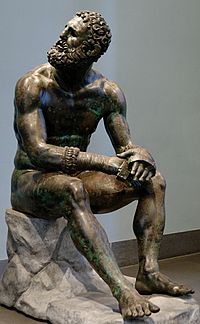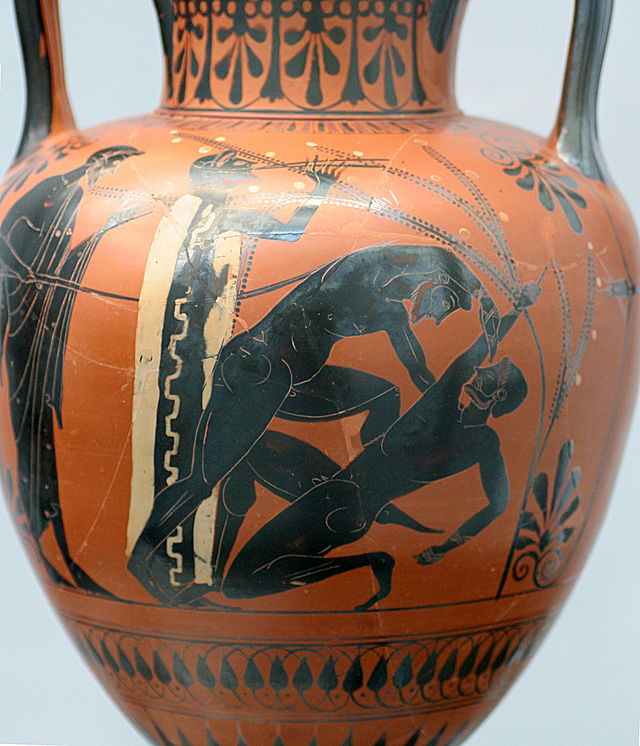Loading AI tools
From Wikipedia, the free encyclopedia
Ancient Greek boxing (Greek: πυγμαχία pygmachia, "fist fighting") dates back to at least the 8th century BC (Homer's Iliad), and was practiced in a variety of social contexts in different Greek city-states. Most extant sources about ancient Greek boxing are fragmentary or legendary, making it difficult to reconstruct the rules, customs and history surrounding this activity in great detail. Still, it is clear that gloved boxing bouts were a significant part of ancient Greek athletic culture throughout the early classical period.
 | |
| Also known as | Ancient Olympic boxing |
|---|---|
| Focus | Striking |
| Hardness | Full contact |
| Country of origin | Greece |
| Descendant arts | Boxing |
| Olympic sport | Ancient |

There is archeological and artistic evidence of ancient Greek boxing (πύξ - pyx[1] or πυγμή - pygme[2] in Αncient Greek) as early as the Minoan and Mycenaean periods. There are numerous legends about the origins of boxing in Greece. One legend holds that the heroic ruler Theseus invented a form of boxing in which two men sat face to face and beat each other with their fists until one of them was killed. In time, the boxers began to fight while standing and wearing gloves (with spikes) and wrappings on their arms below the elbows, but otherwise they fought naked.
According to the Iliad, Mycenaean warriors included boxing among their competitions honoring the fallen, though it is possible that the Homeric epics reflect later Greek culture. Boxing was among the contests held in memorial of Achilles' slain friend Patroclus, toward the end of the Trojan War. It was in commemoration of Patroclus that the Greeks later introduced boxing (pygme / pygmachia) to the Olympic Games in 688 BC. Participants trained on punching bags (called a korykos). Fighters wore leather straps (called himantes) over their hands (leaving the fingers free), wrists, and sometimes breast, to protect themselves from injury. There was no protection for the face or head, meaning Greek boxing was quite dangerous compared to modern day boxing. Women were prohibited to watch games, especially boxing.
The scholar and historian Philostratus maintained that boxing was originally developed in Sparta. The early Spartans believed helmets were unnecessary and boxing prepared them for the inevitable blows to the head they would receive in battle.[3] However, Spartans never participated in the competitive aspect of boxing, believing the means of defeat to be dishonorable.[4]


The style of protection utilized on the hands and knuckles could determine the style of fighting for the competitors. From the time of the Iliad until around 500 BC, himantes were used as protection for the knuckles and hand. They were thongs of ox hide approximately 3.0–3.7 m (9.8–12.1 ft) long that were wrapped around the hands and knuckles numerous times. The thongs usually had loops in which an athlete could insert four of his fingers and clench them together in a fist. Generally, this was the only form of protection worn by participants from the era of Homer until the end of the fifth century. Classical sources describe these as "soft gloves", though modern study has indicated that these thongs were far from soft and were protection for the knuckles, not to soften the blow to the opponent, much like modern padded gloves, which protect the hand, allowing for harder punches. They can be found on many vases excavated from the fifth and sixth century BC.[5]
In around 400 BC sphairai were introduced. The sphairai were very similar to himantes. The only notable difference was that they contained a padded interior when wrapped around the hands and the exterior of the thong was notably more rigid and hard. In addition, "sharp thongs" were introduced during this time period to facilitate greater damage and remained popular up until around 200 AD.[5][6]
Soon before the implementation of the sphairai, the oxys were introduced to boxing. They consisted of several thick leather bands encircling the hand, wrist, and forearm. A band of fleece was placed on the forearm to wipe away sweat. Leather braces extended up the forearm to give greater support when punching and the knuckles were reinforced with leather as well.[7]
Korykos were the equivalent to modern punching bags. They were used for practice in the Palaestra and were filled with sand, flour, or millet. They were commonly depicted in art depicting boxing of the time.[5]


The currently accepted rules of ancient Greek boxing are based on historical references and images. Although there is some evidence of kicks in ancient Greek boxing,[8][9][10] this is the subject of debate among scholars.[11][12] Because of the few intact sources and references to the sport, the rules can only be inferred.[13]

Unlike modern boxing, the Greeks did not enclose the competitors in a ring to encourage fighting in close quarters. Therefore, most boxers fought defensively as opposed to offensively to encourage patience and caution. In addition, boxing in ancient Greece was not divided into individual rounds. Competitors fought until finish, usually by surrender or mutual exhaustion. Felled boxers could be attacked without consequence, just as if they were standing.[5]
The modern practice of dividing boxers into weight classes was an unheard of among the Greeks. Typically, any man who wished to participate in the event was welcome to regardless of strength or muscle mass, and participants competed with each other through random drawings.[5]
The precise rules of boxing in antiquity cannot be known for certain, and are thus inferred from historical references and images. It is believed that any type of blow with the hand was permitted, though using the hands to gouge at the eyeballs was not. Holding or wrestling one's opponent was also prohibited. If the fight lasted too long due to the tenacity of the competitors, the athletes could choose to hit each other in turn without either man defending themselves, to speed up the process of a knockout or surrender. Judges probably enforced the rules by beating the offenders with a switch or a whip.[5]
 Gallo-Roman boxing mosaic (Getty Villa) | |
| Also known as | Pugilatus |
|---|---|
| Focus | Striking |
| Hardness | Full contact |
| Country of origin | Ancient Rome |
| Parenthood | Greek boxing |
| Descendant arts | Bare-knuckle boxing, Modern Boxing |
| Olympic sport | Ancient (banned in 400 AD) |
The form of boxing in the Roman Empire was called pugilatus, from pugnus, "fist" (Greek pygme). Greek influence came through the Etruscans. Boxing was a very popular sport until it was banned around 400 CE by Theodosius the Great because of its violence.[14] Evidence for Roman boxing comes from ancient literature, sculpture, wall paintings, and mosaic.
Techniques and rulesets were similar to Greek boxing:
The following actions were violations:
The main difference between them were the gloves used: instead of the oxys, the Romans used the caestus, gloves made with metal knuckles, that required sheepskin reinforcement that wrapped all the way up the shoulder. Several depictions of caesti show them armed with spikes or blades.[16]
Another main difference was the fighting position, in which the boxer stood upwards instead of bending himself.
The match ending was also changed, as tap outs weren't allowed in the beginning, but submissions were later added for safety measures.[17] One of the reasons pugilatus was later banned was its brutality, as matches often ended with the death of one competitor. Boxers also suffered serious injuries, including bruises, concussions, brain damage, internal hemorrhages and broken bones.[16]
Seamless Wikipedia browsing. On steroids.
Every time you click a link to Wikipedia, Wiktionary or Wikiquote in your browser's search results, it will show the modern Wikiwand interface.
Wikiwand extension is a five stars, simple, with minimum permission required to keep your browsing private, safe and transparent.